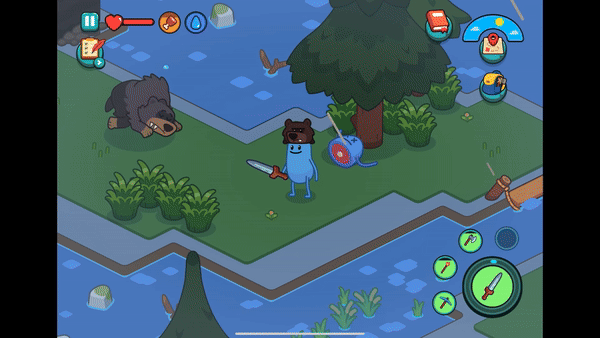Dumb Ways to Survive
Responsibilities:
-
Designing and iterating the core combat and harvesting mechanics, including creature and encounter designs.
-
Balancing the in-game economy, resource drop-rates and difficulty settings.
-
Liaising with Netflix to maintain a consistent understanding of the title's core design pillars and audience focus.
-
Writing and maintaining documentation, including; the game design document, economy spreadsheets and user-test records.
-
Consistent playtesting, bug tracking and pacing tweaks of moment-to-moment gameplay.
-
Providing feedback to other designers and tweaking level designs.

.webp)
.webp)
Case Study: Designing Accessible Combat
Exclusive to the Netflix Games platform on mobile devices, Dumb Ways to Survive (DWTS) is an accessible survival adventure designed for a casual audience. Helming our combat design, I analysed the combat in similar survival titles to determine the best ways we could simplify these systems without losing their strengths.
1. Combat should be understood at a glance and require no explicit tutorialisation.
Understanding that DWTS may be the first real-time, action based game that a large portion of our player-base engages with, we put extra emphasis into ensuring the visual and audio design of our combat mechanics are simple and easy to interpret for a wide audience. When players enter combat, the background music first changes to a more intense track to communicate the pressure of the situation.

The attack indicator UI communicates the timing and power of the Sphinxes attacks.
Creatures don't attack the player immediately, instead, they telegraph their attacks with a dramatic wind-up animation while projecting an attack indicator onto the ground, this indicator gradually fills with gradient colour to warn players to get out of the way. As I designed more combat encounters, I varied the complexity by applying multiple attack-types to certain creatures: using different indicator shapes and timing to communicate the danger and power of each attack.
2. Enemies should feel oppressive, but engaging them should be largely optional.
Enemy creatures in DWTS were designed to fall into one-of-four different AI behaviour types based on how they react to the player's presence.
Docile:
- Runs away when struck by the player
Passive:
- Runs away when the player is nearby
Reactive:
- Attacks when struck by the player
Aggressive:
- Attacks when the player is nearby

The player chooses to engage a sleeping bear by waking it up.
Creature encounters were designed such that a majority of aggressive creatures only appear during the night, creating a dynamic with our exploration systems that subtly allows players to choose their own difficulty. Skilled players will overcome aggressive nighttime creatures to obtain unique resources, whereas more casual players will choose to return to the campsite and sleep through the night, avoiding most difficult combat encounters and facing no penalty for playing this way.
As a player progresses through the game, the number of aggressive/reactive creatures slowly increases, culminating in a mandatory final boss encounter that trusts that players reaching this point have mastered the title's combat mechanics.
3. Combat should have a low barrier-to-entry but reward skilled play.
As weapons share the same equipment slots as harvesting tools, we effectively teach players how to engage in combat when they interact with the action button for the first time.
During early user tests however, we took note that players could spam the action button as quickly as possible to overcome enemy creatures, this dominant-strategy was popular with casual players but made repeat combat encounters stale and repetitive for players familiar with action games.

By avoiding weapon spam, this player saves their weapon durability and avoids waking the ghost knight.
Through several iterations of our combat mechanics, I devised a solution to reduce the effectiveness of this playstyle without punishing casual players for spamming attacks. Attacking repeatedly in succession fills a weapon's Charge Meter, once the meter has been filled the next attack will unleash a devastating Charged Attack that does bonus damage and can inflict status effects. This dramatic attack creates a pause in combat pacing where players may stop for a moment, considering whether they should hold on to the Charged Attack for a high-value target or to hit multiple creatures at once.
Ultimately, casual players may continue attacking as frequently as they like and take little notice of the system, however players who find this repetitive will utilise Charged Attacks to their fullest and, by investing in a more methodical approach to combat, are rewarded for paying attention.




